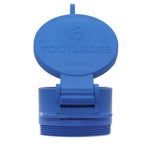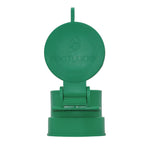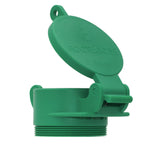You have no items in your shopping cart.
Outdoor environments are relentless on infrastructure. Whether in coastal cities, refineries, or municipal streets, manhole covers are constantly exposed to sunlight, salt spray, and industrial runoff. These conditions accelerate corrosion, fade coatings, and weaken materials over time—especially for traditional cast iron. Composite manhole covers, by contrast, are engineered to resist UV radiation, chemical exposure, and corrosion from the inside out. The result is a safer, longer-lasting, and more sustainable solution for public utilities and industrial access points.
Quick Spec Comparison
| Performance Factor | Composite Covers | Cast Iron Covers |
|---|---|---|
| UV Resistance | Excellent—UV inhibitors built into material; no coating required | Moderate—paint or coating required; fades and peels over time |
| Corrosion Resistance | Immune to rust, salt, and H₂S exposure | Prone to oxidation; needs repainting or coating |
| Chemical Resistance | Stable against fuels, acids, and solvents | Limited; dependent on surface protection |
| Weight & Handling | Up to 70% lighter; one-person handling possible | Heavy; two-person or mechanical lifts required |
| Maintenance Needs | Minimal—no coating renewal or blasting | High—repainting and inspection cycles required |
| Theft Risk | None—non-metallic, no scrap value | High—metal theft still common |
How Cast Iron Handles the Outdoors
Cast iron has served for centuries, and its strength under load remains unmatched. But it has one vulnerability: oxidation. Without continuous maintenance, iron reacts with water and oxygen, forming rust that compromises both appearance and structure. Even when coated, UV and salt exposure can degrade paint films over time. Municipalities often face recurring repainting cycles and inspection costs to keep cast iron lids serviceable. In high-salt coastal regions, corrosion can appear within a year. Industrial zones with acidic runoff or hydrogen sulfide (H₂S) exposure face even faster deterioration. Over time, lids can seize in their frames or lose cross-sectional strength, increasing both labor and replacement costs.
Composite Covers: Built for Environmental Exposure
Composite manhole covers—made from fiber-reinforced polymer (FRP) or sheet-molding compound (SMC)—solve these problems by design. The material matrix is inherently resistant to rust, salt, and most chemicals. UV-stable pigments are blended throughout the resin rather than applied as a coating, so color and performance remain consistent for years without repainting.
Key advantages of composites include:
-
Zero corrosion: No metal to oxidize, even in salt air or wastewater environments.
-
UV resistance: Integrated UV inhibitors prevent fading, chalking, and surface embrittlement.
-
Chemical durability: Stable against acids, alkalis, fuels, and most solvents.
-
Non-conductive: Ideal for electrical, fuel, and data infrastructure.
-
Low maintenance: No sandblasting, painting, or coating cycles required.
These advantages make composites particularly effective for coastal cities, refineries, wastewater plants, and roadways exposed to deicing salts or industrial discharge.
Comparing Composite vs. Cast Iron: Field Performance
Composites outperform cast iron in every environmental category except raw compressive strength—an area where both can meet EN 124 D400 or AASHTO M306 load standards. Where cast iron relies on coatings, composites rely on chemistry. UV inhibitors and inert fillers protect the entire cross-section, meaning even surface wear won’t expose a weaker substrate underneath.
UV Resistance in Harsh Conditions
Sunlight is one of the most destructive forces for outdoor materials. Prolonged UV exposure causes chalking, fading, and brittleness in painted or unprotected metal surfaces. Composites counter this by incorporating UV-stable resins and pigments directly into the polymer matrix. Testing under ASTM G154 (accelerated UV aging) shows minimal color shift and no loss of mechanical strength after thousands of hours—making composites ideal for regions with high solar exposure.
Corrosion and Saltwater Performance
Corrosion remains the number one reason cast iron lids fail prematurely. In coastal zones or regions that use road salt, corrosion accelerates rapidly. Composite covers are chemically inert to chloride ions and don’t require cathodic protection or coating renewal. In wastewater treatment and sewer gas environments, FRP materials resist hydrogen sulfide (H₂S) corrosion, protecting both cover and gasket integrity. This makes composites the clear choice for long-term reliability in marine and chemical-exposed sites.
Chemical Resistance and Industrial Durability
Industrial and environmental applications expose manhole assemblies to a wide range of chemicals—from acidic runoff and hydrocarbons to solvents and alkalis. Composite covers have a broad resistance spectrum, validated through ASTM D543 chemical immersion testing. They perform reliably around fuel stations, chemical storage areas, and remediation sites where metal lids would corrode or weaken. For highly specialized applications, resin formulations can be tailored for extra resistance to specific compounds like chlorine, ammonia, or caustic soda.
Long-Term Lifecycle Cost Advantages
The true savings of composite materials emerge over time. While upfront costs can be similar to cast iron, lifecycle value increases through:
-
No corrosion maintenance or repainting cycles
-
Fewer injuries and lower handling costs
-
Reduced theft risk
-
Extended service life with no material fatigue
Municipalities switching to composite lids often report payback within three years through avoided labor and replacement costs alone.
Sustainability and Modern Infrastructure Goals
Beyond durability, composites align with sustainability goals. Their long service life, reduced maintenance, and recyclability make them a better environmental choice. Lighter weight also lowers transportation emissions and handling energy—an important factor in modern public works procurement.
Final Thoughts
Cast iron has a long legacy, but environmental exposure challenges its practicality in today’s conditions. Composite manhole covers provide a lighter, stronger, and corrosion-free alternative that thrives under sunlight, salt, and chemical exposure. They keep crews safer, reduce maintenance budgets, and help cities meet sustainability goals. For an in-depth look at field results and performance data, read our post Top Benefits of Composite Manhole Covers: Why Make the Switch
Enviro Design Products — delivering durable, American-made infrastructure solutions that stand up to time, weather, and real-world use.









